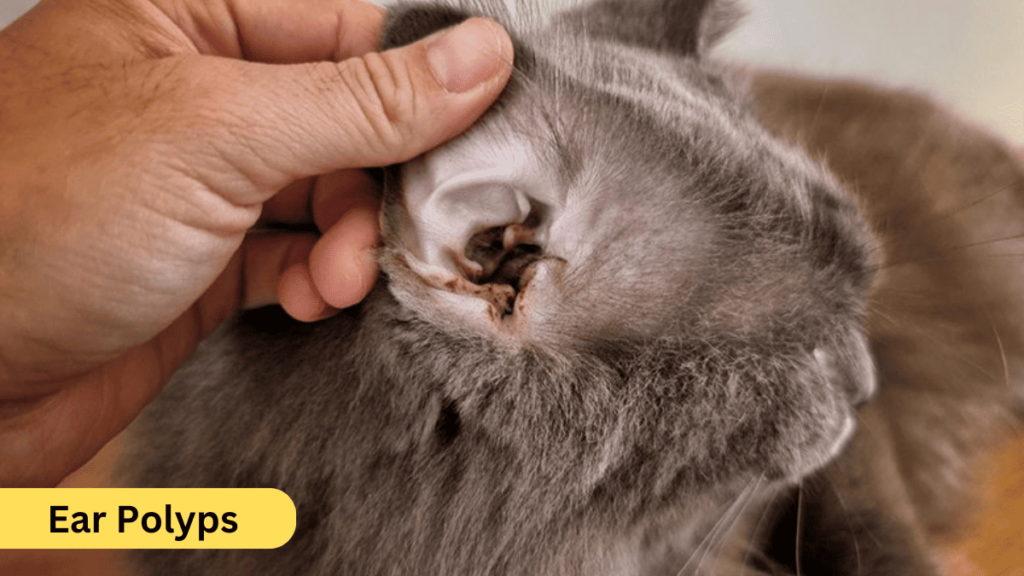Ear polyps in cats can be a concerning condition for pet owners. These non-cancerous growths, often found in the ear canal or throat, can cause discomfort and serious health complications if left untreated. This guide provides a comprehensive look at Ear Polyps in Cats Treatment: 2025 Guide. By the end, you’ll have a thorough understanding of how to manage and treat this condition, helping your feline companion lead a healthier life.

Table of Contents
What Are Ear Polyps in Cats?

Ear polyps, also known as nasopharyngeal or inflammatory polyps, are benign masses originating from the middle ear or the eustachian tube. These growths can extend into the ear canal, throat, or both. Unlike malignant tumors, polyps do not spread to other parts of the body but can still cause significant discomfort and secondary complications.
Key Facts About Ear Polyps in Cats
| Attribute | Details |
|---|---|
| Type | Non-cancerous, benign growth |
| Location | Middle ear, ear canal, or nasopharyngeal region |
| Age of Onset | Common in cats under 2 years old |
| Recurrence Rate | High without advanced surgical treatment |
Causes of Ear Polyps in Cats
The exact cause of ear polyps remains unclear, but certain factors may contribute:
- Chronic Infections: Persistent ear or upper respiratory infections may trigger polyp formation.
- Immune System Suppression: Conditions like Feline Leukemia Virus (FeLV) or Feline Immunodeficiency Virus (FIV) can increase the risk.
- Inflammatory Response: Chronic inflammation in the middle ear or eustachian tube may lead to polyp development.
Signs and Symptoms
Ear polyps can manifest differently based on their location:
In the Ear Canal
- Scratching or pawing at the ear
- Head shaking
- Foul-smelling ear discharge (yellow, green, or bloody)
- Sensitivity when the ear is touched
In the Nasopharyngeal Region
- Snorting or noisy breathing
- Difficulty swallowing or eating
- Nasal discharge (clear or blood-tinged)
- Sneezing
Advanced Symptoms
- Head tilt
- Loss of balance
- Unequal pupil sizes
- Walking in circles
Diagnosis of Ear Polyps
Diagnosing ear polyps requires a thorough veterinary examination:
Diagnostic Methods
| Procedure | Purpose |
|---|---|
| Physical Examination | Detect visible polyps in the ear canal or throat |
| Otoscopy | Visual inspection of the ear canal and eardrum |
| Imaging (X-ray, CT, MRI) | Assess the extent of polyp growth in the middle ear and surrounding areas |
| Biopsy | Confirm diagnosis by analyzing a sample of the polyp tissue under a microscope |
Read More:
Cat Stomatitis Treatment: 2025 Complete Guide
Treatment Options for Ear Polyps in Cats
1. Manual Extraction
This method involves using forceps to remove the polyp through the ear canal or throat. While straightforward, this approach has a high recurrence rate (up to 50%).
2. Bulla Osteotomy Surgery
For severe or recurring cases, a ventral bulla osteotomy is the most effective treatment. This surgical procedure involves:
- Making an incision beneath the neck to access the middle ear.
- Removing part of the bulla bone to extract the polyp completely.
Pros:
- Significantly lowers recurrence rates.
- Addresses the root cause of the condition.
Cons:
- Invasive and requires anesthesia.
- Risk of surgical complications, such as nerve damage.
3. Holistic Treatment
For cat owners seeking natural remedies, holistic approaches may help manage symptoms:
- Herbal Ear Drops: Chamomile and calendula drops can soothe irritation.
- Dietary Changes: A diet rich in omega-3 fatty acids and antioxidants supports immune health.
- Acupuncture: May help reduce inflammation and improve overall well-being.
Note: Holistic treatments are complementary and should not replace veterinary care.
Aftercare and Recovery
Post-treatment care is crucial for a cat’s recovery. Follow your veterinarian’s guidelines, which may include:
- Administering prescribed antibiotics or anti-inflammatory medications.
- Regularly cleaning the ear with vet-approved solutions.
- Monitoring for signs of recurrence, such as head shaking or ear discharge.
Prognosis
With proper treatment, most cats recover well from ear polyps. However, recurrence is common with simple extraction methods. Advanced surgical interventions like bulla osteotomy offer a more permanent solution.
FAQs About Ear Polyps in Cats
1. What are the pictures of ear polyps in cats treatment?
Images of affected ears can help identify polyps. Consult your veterinarian for visual aids or imaging results.
2. Can holistic treatment for ear polyps in cats be effective?
While holistic treatments may alleviate symptoms, they do not remove polyps. Always consult your vet before starting any alternative therapies.
3. Are ear polyps in cats contagious?
No, ear polyps are not contagious and do not spread between animals.
Comparison Table: Treatment Methods
| Treatment Method | Effectiveness | Recurrence Risk | Cost |
|---|---|---|---|
| Manual Extraction | Moderate | High | $300–$700 |
| Bulla Osteotomy Surgery | High | Low | $1,500–$3,000 |
| Holistic Treatments | Supportive only | Not applicable | $50–$200 per month |
Final Thoughts
Ear polyps in cats are manageable with timely diagnosis and appropriate treatment. While manual extraction may provide temporary relief, advanced surgical methods like bulla osteotomy offer the best outcomes. For those exploring holistic treatments, consider them as supportive care alongside veterinary advice.
By understanding the signs, causes, and treatment options, you can ensure your cat receives the best care possible, paving the way for a full recovery.
